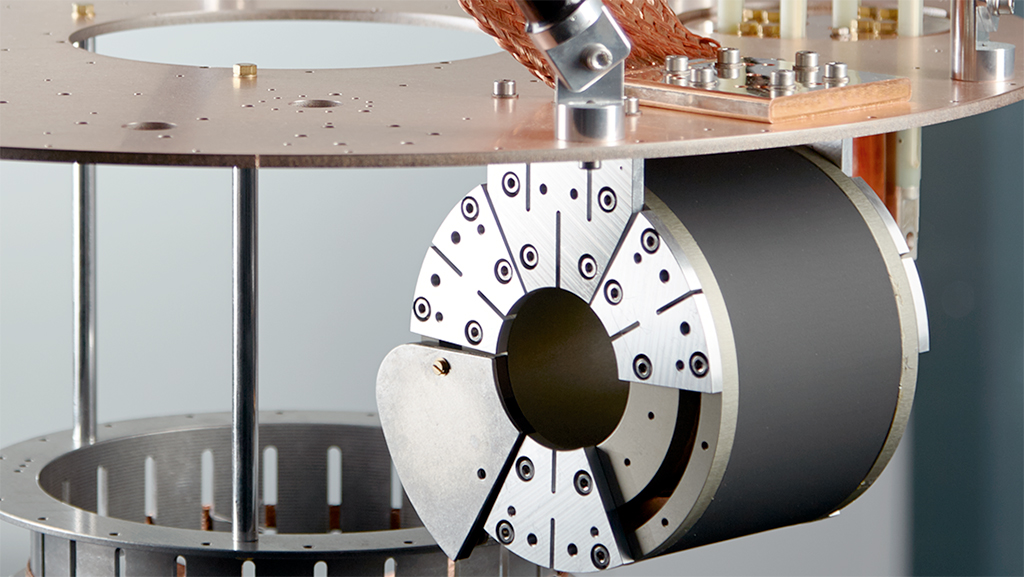
What is Magnetic Refrigeration?
How does magnetic refrigeration work?
Magnetic refrigeration aids in producing extremely low temperatures at almost absolute zero temperature (called sub-Kelvin temperatures, i.e., well below -272°C) by cleverly using the relationship between a magnetic field and entropy in certain materials.
Entropy, in simple terms, refers to the disorder or randomness in a system. In magnetic materials, the entropy is composed of essentially two parts: first, the entropy of the crystalline structure, where larger entropy means higher temperature due to vibrations of the crystal lattice. Second, as the atoms in the material carry a magnetic moment, the entropy of the spin system. A spin system is merely a collection of magnetic moments – imagine tiny compass needles – pointing randomly in various directions. The way the entropy of this spin system responds to a magnetic field is at the very core of magnetic refrigeration.
To illustrate: when the temperature is high, these magnetic moments are oriented in a completely uncoordinated fashion – their entropy is constant because there is no overall order to their direction. Even if we applied a magnetic field to force the magnetic moments into a specific direction, they would keep their random orientation, because thermal fluctuations are so strong that they ruin magnetic ordering immediately. This changes at lower temperature: When the temperature drops, the entropy can also be influenced by the magnetic field. The magnetic moments can then be ‘polarized’; in other words ‘forced’ into a common direction by applying a strong enough magnetic field.
Herein lays the working principle of magnetic refrigeration: If we lessen the magnetic field, while keeping the total entropy constant, the increase of entropy of the spin system (during the randomization of the magnetic moments) is counteracted by a drop of the lattice entropy – and we witness a drop in temperature. In simple terms, it’s like using a magnet to control how orderly or disorderly the tiny magnets in a material are, and this change in orderliness can make the material cool down or heat up. So, by controlling a magnetic field, we can create a refrigerator that cools by manipulating the magnetic moments of a polarizable material.
Magnetic cooling is also known as adiabatic demagnetization refrigeration, or ADR for short.
Advantages of magnetic refrigerators
In the contemporary realm of cooling solutions, magnetic refrigeration is emerging as a useful technology. And for good reason:
- Cryogen-free operation: Unlike other traditional refrigeration methods, magnetic refrigeration does not rely on cryogenic liquids.
- Reduced energy consumption: By utilizing the magnetocaloric effect, where a magnetic field modifies a magnetocaloric material’s thermal conditions, magnetic refrigeration consumes less energy by eliminating the requirement for extra pumps and compressors that are essential in conventional gas-based refrigeration systems.
- Scalability: The technology’s inherent flexibility ensures it can be tailored for various applications, from small-scale labs to industrial facilities. Magnetic cooling, crucial for scalability, doesn’t depend on scarce resources like helium-3, unlike current dilution cooling. This makes it suitable for the extensive cooling needs of a growing quantum industry, surpassing what helium-3 can offer.
Delving into adiabatic demagnetization refrigeration
Adiabatic Demagnetization Refrigeration (ADR) may sound quite complicated, but let’s break it down into simpler terms.
1. ‘Adiabatic’ refers to a process where there is no heat exchange with the surrounding environment. In simpler terms, inside the system we’re interested in, everything that happens stays inside.
2. ‘Demagnetization’ means reducing the magnetic field. Imagine several small magnets all lined up due to a strong magnetic field. If we slowly reduce this field, these magnets lose their alignment and start moving freely.
3. ‘Refrigeration’, as we know, refers to the cooling process. Now, how does it connect to ‘Adiabatic’ and ‘Demagnetization’?
When we reduce the magnetic field in our system that does not exchange heat with its surroundings (adiabatic), the magnetic moments orient randomly. To change from the aligned state to the disordered state, these particles require energy, and they take this energy from their surroundings in the form of heat. This process of absorbing heat makes the surroundings cooler, thus accomplishing refrigeration.
kiutra’s innovation: cryostats & continuous ADR
Continued adiabatic demagnetization refrigeration (cADR) is a variant of adiabatic demagnetization refrigeration (ADR) that provides continuous cooling at ultra-low temperatures close to absolute zero. The cADR is a multi-stage cooling system that consists of at least two ADR units and works by cooling with the one ADR unit while the other one is being regenerated and vice versa. This is a significant improvement over the ADR because it provides continuous cooling, whereas the ADR is a ‘single-shot’ device that can only hold the object being cooled to mK temperatures for up to several days.
kiutra has incorporated continuous Adiabatic Demagnetization Refrigeration (cADR) into our cryostats. These robust, low-temperature devices, vital in quantum technologies, help achieve and maintain super-cold temperatures sans cryogenic liquids, underscoring their ‘cryogen-free’ label.
You can learn more about the science behind kiutra’s technology here.
The advantages kiutra brings to the table
With kiutra leading the charge, the future of magnetic refrigeration appears incredibly promising. Our offerings epitomize:
- Scalability: Cooling independent of rare helium-3, the devices future-proof quantum technologies and pave the way to a cold quantum industry.
- Energy efficiency: Consuming less power, these are models of sustainability.
- Operational excellence: User-friendly design coupled with reduced downtime and maintenance costs.
Conclusion
Magnetic refrigeration has a long history however recent innovations in continuous operation allow for new use cases. kiutra’s innovative approach, grounded in almost a century of magnetic refrigeration history, is supporting a sustainable, scalable, and industrious quantum technology future.